Edward Vernon
Admiral Edward Vernon (12 November 1684 – 30 October 1757, Orwell Park) was an English naval officer. He had a long and distinguished career, rising to the rank of admiral after 46 years service. As a vice admiral during the War of Jenkins' Ear, in 1739 he was responsible for the capture of Porto Bello, seen as expunging the failure of Admiral Hosier there in a previous conflict. However, his amphibious operation against the Spanish port of Cartagena de Indias was a disastrous defeat. Vernon also served as a Member of Parliament (MP) on three occasions and was outspoken on naval matters in Parliament, making him a controversial figure.
Edward Vernon | |
|---|---|
 Admiral Edward "Old Grog" Vernon. Portrait by Thomas Gainsborough | |
| Nickname(s) | "Old Grog" |
| Born | 12 November 1684 Westminster, London, England |
| Died | 30 October 1757 (aged 72) Nacton, Suffolk, England |
| Allegiance | |
| Service/ | |
| Years of service | 1700–1746 |
| Rank | Admiral |
| Commands held |
|
| Battles/wars | |
| Other work | |
The origin of the name "grog" for rum diluted with water is attributed to Vernon. He was known for wearing coats made of grogram cloth, earning him the nickname of "Old Grog", which in turn came to mean the diluted rum that he first introduced into his naval squadron. He is also the namesake of George Washington's estate Mount Vernon, and thereby the many places in the United States named after it.
Early life
Born in Westminster, London, Vernon was the second son of James Vernon, secretary of state to William III. Edward had one other sibling, James who became British envoy to Denmark and served as a member of parliament and Clerk of the Privy Council. Vernon briefly attended Westminster School, then joined the Royal Navy on 10 May 1700 as a Volunteer per order on board HMS Shrewsbury. Vernon's secondary education was sharply at odds with the norm for Royal Navy officers of his day, most of whom received an elementary education before they were sent to sea at about the age of twelve.
War of the Spanish Succession
In March 1701, he was transferred to HMS Ipswich and three months later, joined HMS Mary. On 16 September 1702, Vernon was promoted lieutenant and appointed to HMS Lennox serving in the Channel Squadron. The ship was later transferred to the Mediterranean and finally paid off in March 1704. He was then appointed to HMS Barfleur, which at the time was the flagship of Admiral Cloudesley Shovell in the Mediterranean. The ship was present at the capture of Gibraltar and the Battle of Málaga.
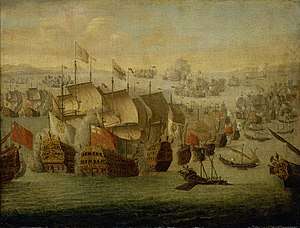
In December, with Shovell, he transferred to HMS Britannia and was present at the capture of Barcelona in 1705.
On 22 January 1706, he was promoted captain and appointed to HMS Dolphin. However, he was moved ten days later into HMS Rye and remained in the Mediterranean until 1707. With the rest of Shovell's fleet, he returned to England, but was fortunate to escape the disaster that befell Shovell’s flagship, HMS Association at the Isles of Scilly. In November, he joined HMS Jersey and in April 1708, took command of the West Indies station. In 1710, he successfully broke up a Spanish squadron off Cartagena. At the end of the War of the Spanish Succession in 1712, he returned to Britain.
Peace, promotion and Parliament
In March 1715, he was appointed to HMS Assistance, in which he served in the Baltic until 1717, when the ship was paid off. After this, he was put on half pay for the next eighteen months. In March 1719, he was appointed to HMS Mary and returned to the Baltic. Vernon was the commodore on the Jamaica Station in 1720.[1] In 1721, he again went on half pay for five years. During this period, he became the Member of Parliament for Penryn and took a leading part in naval debates. In 1726, he was re-appointed to active service in HMS Grafton. This ship served in the Baltic until the winter of 1727, when it was transferred to the fleet at Gibraltar after Spain declared war on Britain. In May 1728, peace was made with Spain, and Vernon returned to Britain and resumed his Parliamentary duties. He took up the case of the Welshman Robert Jenkins, a merchant seaman who claimed to have had his ear cut off after his vessel was boarded by Spanish privateers Coast guards or privateers guardacostas in 1731.
War of Jenkins' Ear
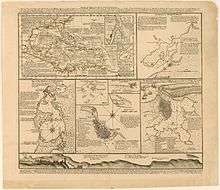
The accumulation of Spanish-British conflicts led to the War of Jenkins' Ear in 1739, in which Vice Admiral Vernon led a fleet along with Major General Thomas Wentworth. Vernon captured Porto Bello, a Spanish colonial possession, as a result of which he was granted the Freedom of the City of London. However, Vernon's next campaign against the Spanish, a large-scale assault on Cartagena de Indias in 1741, ended in disaster. After initial success, the British fleet of 186 ships and around 12,000 infantry was defeated by a garrison of 3,500 men and the sailors disembarked from the six ships of the line commanded by the one-eyed, one-legged and one-armed Spanish admiral Blas de Lezo. As disease spread among the British troops, delaying tactics by the Spaniards and a failed assault on the last fortification defending the city led a council of war to decide to abandon the siege and withdraw to Jamaica. The assault was further marred by bitter quarrels with Wentworth. After a further year and a half ineffectually campaigning in the Caribbean, Vernon was recalled back to England to find he had been elected MP for Ipswich.
During the War of Jenkins' Ear, Vernon was promoted vice admiral of the blue on 9 July 1739 and, as he had prominently spoken for both the war and the Navy, he was given the command of a squadron of six ships assigned to the Jamaica Station.[1] The Gentleman's Magazine reported England's preparations for war against Spain in July 1739, noting that Vernon had been recalled to active duty and promoted; that, on 10 July King George II had instructed the Lords of the Admiralty to prepare Letters of Marque; and (a week after the fact) it reported Vernon and his squadron had sailed for the West Indies on 20 July.[2]
Despite the unmistakable signs of Great Britain preparing for a naval war in the summer of 1739, the formal declaration of war against Spain was not announced in London until Saturday, 23 October 1739.[3]
Porto Bello
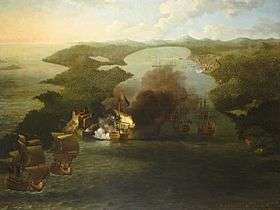
by Samuel Scott
On 21 November 1739 Vernon captured the Spanish colonial possession of Porto Bello (now in Panama) using just six ships (against the 90-man Spanish garrison). Vernon was subsequently granted the Freedom of the City of London and commemorative medals were produced. The Portobello areas in London, Dublin and Edinburgh (see Portobello Road and Portobello, Dublin) are named after this victory, and "Rule, Britannia!" was composed by Thomas Arne during the celebrations in 1740. A tower commemorating his victory was erected by members of the Vernon family living at Hilton Hall outside Wolverhampton.[4]
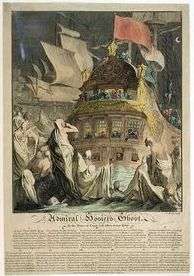
Addressed by Hosier's Ghost
Vernon's action was seen by the "Patriots", or pro-war party opposed to Robert Walpole, as just vengeance for Admiral Hosier's disastrous blockade of Porto Bello during 1726-28, where with a greater force of 20 ships, and Porto Bello inadequately defended, government orders forbade him from firing a shot, leaving him and some 4,000 sailors to linger ineffectually off the shore and to die of tropical disease. The ballad "Admiral Hosier's Ghost" was written by Richard Glover following Vernon's triumph as an attempt to remind Walpole of his previous failed policy of inaction and to check any basking in Vernon's glory on his part. In the ballad, the ghost of Hosier appears to Vernon as he rests at anchor following his successful engagement, and congratulates him:
Unrepining at thy glory
Thy successful arms we hail.
He then charges him to let Hosier's wrongs prevail when he returns to England, upon which he and his fellow ghosts can finally rest, their reputations restored. The first half of verse 7 is thus:
For resistance I could fear none
But with twenty ships had done
What thou brave and happy Vernon
Hast atchiev'd with six alone.
Cartagena de Indias
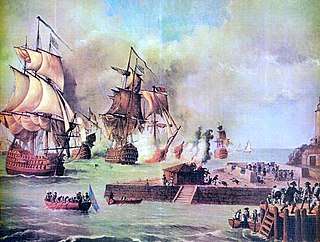

In April 1741, with a much larger fleet and land forces under Major General Thomas Wentworth, 26,600 men and 186 ships,[5] Vernon turned his attention to Cartagena de Indias. Following initial success, Vernon wrote to England to inform that his forces had penetrated Cartagena's outer defences, giving rise to much celebration. The souvenir industry produced masses of commemorative material, including medals, prints and china. However, Vernon and Wentworth did not get on, and the former was frustrated at the land forces' cautious and slow progress, considering the rainy season was already upon them. Given the time factor, it was decided to assault the last remaining substantial fortification before the city without artillery preparation.[6] An epidemic of yellow fever, typhus, scurvy and dysentery, which ravaged the troops ashore, compounded the problems and the force returned to Port Royal.[7] A reflection of the bitter quarrel between Vernon and Wentworth is the inscription on Vernon's marble memorial in Westminster Abbey: "...and at Carthagena (Vernon) conquered as far as naval forces could carry victory".[8]
At the end of May 1741, the British forces in the Caribbean decided to attack Cuba. Vernon captured Guantánamo Bay, briefly renaming it Cumberland Bay. He arrived with a force of eight warships and 4,000 soldiers with plans to march on Santiago de Cuba, but finally abandoned the half-hearted attempt in December after sickness broke out again. Vernon could no longer hold back his anger at what he perceived as Wentworth’s ineptitude and a bitter quarrel ensued ending in the recall of both parties to Britain at the end of 1742.
Further political career
While he had been away, Vernon had been elected MP for Ipswich, after having purchased the Orwell Park estate in Nacton, Suffolk. Vernon returned to Parliament and continued to harass the government on naval affairs. In 1745, Vernon was promoted to admiral and appointed to command the North Sea Fleet in response to the threat from the French forces in support of Charles Edward Stuart ("Bonnie Prince Charlie"). This was his last operational command. When the Admiralty refused to grant him the status of Commander-in-Chief, he asked to be relieved on 1 December 1745.[9] Vernon's naval career had, however, a controversial ending. He wrote two pamphlets about his disagreements with the Admiralty. The first was entitled "A Specimen of Naked Truth from a British Sailor" and the second "Some Seasonal Advice from an Honest Sailor". As a result, the Admiralty brought the matter to King George II who advised to have his name removed from the navy flag list. He was dismissed on 11 April 1746.[10]
Naval innovation and health
Throughout his career, Vernon had tried to improve naval procedures and encouraged his captains to improve manoeuvres and gun drill. He introduced new instructions to improve the flexibility of handling fleets in battle and formed the basis of continuing improvement to Admiralty fighting instructions by subsequent naval commanders.[11] Vernon continued to serve in Parliament and remained active in the interest of naval affairs until his death at Nacton on 30 October 1757.[12]
His enduring claim to fame was his 1740 order that his sailors' rum should be diluted with water. In 1740, supposedly calling the new drink "grog" after Vernon's nickname "Old Grog", attributed to his habitual wearing of a grogram coat.[13][14] Some writers have claimed that Vernon also added citrus juice to prevent spoilage and that it was found to prevent scurvy. This is not the case and is based on a misreading of Vernon's order in which, having instructed his captains to dilute the sailors's daily allowance of rum with water, he says that those members of the crew "which......are good husbandmen may from the saving of their salt provisions and bread, purchase sugar and limes to make it more palatable to them." ][15] In other words, there was no official addition of lime juice or other substance at this time - any addition was the result of a voluntary choice, made by and paid for by the men themselves, and done solely if they wanted to improve the taste. It seems unlikely that many men would have spent their meagre pay on such a thing.
Likewise, it had nothing to do with combating scurvy, which was a disease of long ocean voyages—not of squadrons operating among islands where there was an abundance of fruits and fresh foodstuffs—and was seen by the medical establishment (incorrectly) as the consequence of poor digestion and internal putrefaction.[4] Standard medical remedies focused on 'gingering up' the system by imbibing a variety of (ineffective) fizzy or fermenting drinks.[16] Until an official daily issue of lemon juice was introduced into the Royal Navy in 1795, scurvy continued to be a debilitating disease which destroyed men and disabled ships and whole fleets. Practical seamen and surgeons, however, had known from practical experience that vitamin C, in the form of citrus juice, cured scurvy and in 1795, in defiance of medical opinion, the Admiralty and the admirals introduced lemon juice and sugar as a regular part of the naval diet.[17] When a few years later Spain allied itself with France and lemons became unobtainable, West Indian limes were substituted. It was from this time that British obtained the nickname limeys.
Mount Vernon
George Washington's older half-brother, Lawrence Washington, served on Vernon's flagship HMS Princess Caroline (an 80-gun three-decker) as a captain of Royal Marines in 1741. He named his Virginia estate Mount Vernon in honour of his former commander,[18] a name retained by George Washington.
Notes
- Cundall, p. xx
- The Gentleman's Magazine, "Historical Chronicle: Tuesday, 31 July" Vol. 9, July 1739, pp. 383 and 384; accessed 13 May 2010.
- The Gentleman's Magazine, "Historical Chronicle" Saturday 23 October Vol. 9, October 1739, page 551; accessed 13 May 2010.
- "History of Hilton Hall". Archived from the original on 9 September 2015. Retrieved 16 October 2015.
- Paper presented in 2000 to LACLIO Conference at Stanford University Archived 25 September 2007 at the Wayback Machine
- Harding, Richard. Amphibious Warfare in the Eighteenth Century: The British Expedition to the West Indies, 1740-1742. Royal Historical Society: Studies in History, vol. 62. The Boydell Press. London: 1991.
- Crewe, Duncan. Yellow Jack and the Worm: British Naval Administration in the West Indies, 1739-1748. Liverpool University Press: 1993
- Admiral Vernon's memorial at Westminster Abbey
- Hartman, Cyril H. The Angry Admiral: The Later Career of Edward Vernon, Admiral of the White. William Heinemann Ltd. London: 1953.
- Vernon, Edward (1746). Original Letters to an Honest Sailor. London. p. 94.
- Precursors of Nelson: British Admirals of the Eighteenth Century; edited by Peter Le Fevre & Richard Harding; Stackpole Books (London: 2000); Chapter 6 "Edward Vernon" pp. 151-176
- Palmer, Michael A. Command of the Sea: Naval Command and Control since the Sixteenth Century. Harvard University Press. London:2005, pp.101-104
- Pack, James. Nelson's Blood: The Story of Naval Rum. Naval Institute Press. Annapolis:1982, chapter 1 "Old Grogram" pp.1-18.
- "Grogram". Wordsmith.org. 15 July 2014. Retrieved 15 July 2014.
- Ranft., B.,L. The Vernon Papers. vol MCMLVII. London: Navy Records Society. pp. 417–9.
- Vale, Brian (2008). "The Conquest of Scurvy in the Royal Navy 1793-1800: a Challenge to Current Orthodoxy". The Mariner's Mirror. 94 (2): 160–175. doi:10.1080/00253359.2008.10657052.
- Vale, Brain; Edwards, Griffith (2011). Physician to the Fleet; the Life and Times of Thomas Trotter 1760-1832. Woodbridge: The Boydell Press. pp. 29–33. ISBN 978-1-84383-604-9.
- Ranft, Brian, editor. The Vernon Papers. Naval Records Society, vol. 99. London: 1958
References
- Cundall, Frank (1915). Historic Jamaica. West India Committee.
- Harding, Richard (2008). "Vernon, Edward (1684–1757)". Oxford Dictionary of National Biography (online ed.). Oxford University Press. doi:10.1093/ref:odnb/28237. Retrieved 18 July 2010.
- Chisholm, Hugh, ed. (1911). . Encyclopædia Britannica. 27 (11th ed.). Cambridge University Press.
- Laughton, John Knox (1899). . In Lee, Sidney (ed.). Dictionary of National Biography. 58. London: Smith, Elder & Co.
External links
| Wikimedia Commons has media related to Edward Vernon. |
| Military offices | ||
|---|---|---|
| Preceded by Vacant (Last held by Sir Hovenden Walker) |
Commander-in-Chief, Jamaica Station 1720 |
Succeeded by Vacant (Next held by Francis Hosier) |
| Preceded by Sir Chaloner Ogle |
Commander-in-Chief, Jamaica Station 1739–1742 |
Succeeded by Sir Chaloner Ogle |
| Parliament of Great Britain | ||
| Preceded by Viscount Rialton Samuel Trefusis |
Member of Parliament for Penryn 1722–1734 With: Sidney Meadows 1722–1727 Sir Cecil Bishopp 1727–1734 |
Succeeded by Sir Richard Mill John Clavering |
| Preceded by William Wollaston Samuel Kent |
Member of Parliament for Ipswich 1741–1757 With: Samuel Kent |
Succeeded by Thomas Staunton Samuel Kent |